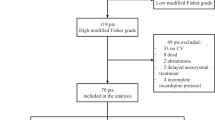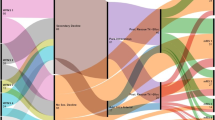Abstract
Background
Delayed cerebral arterial vasospasm is one of the leading causes of death and disability after aneurysmal subarachnoid hemorrhage (aSAH). We evaluated the safety of intraventricular nicardipine (IVN) for vasospasm (VSP) in aSAH patients, and outcomes compared with a control population.
Methods
A retrospective case–control study was conducted for aSAH patients treated with IVN at Mayo Clinic, Jacksonville, FL, from March 2009 to January 2011. Controls were matched by age, gender, and Fisher grade. Safety was evaluated by the incidence of intracranial bleeding and infection. Outcome was measured by Glasgow Outcome Scale at 30 and 90 days. IVN effects on VSP were evaluated by transcranial Doppler (TCD).
Results
Thirteen aSAH patients and one arteriovenous malformation (AVM)-related SAH patient received IVN for VSP and were matched with 14 aSAH patients without IVN therapy for a total of 28 cases. Median dose was 4 mg (range 3–7), and median number of doses was seven (range 1–17). Mean flow velocity decreased after IVN (120.2 and 101.6 cm/s–82.0 and 72.8 cm/s, right and left middle cerebral arteries, respectively). No significant difference was seen in clinical outcomes between controls and cases at 30 days (P = 0.443) and 90 days (P = 0.153). There were no incidences of bleeding or infection with 111 nicardipine injections.
Conclusions
IVN appears relatively safe and effective in treating VSP by TCD, but there was no difference in clinical outcomes between nicardipine and control patients at 30 and 90 days. In the future, larger studies are needed to evaluate the clinical outcome with IVN.


Similar content being viewed by others
References
Edlow JA, Malek AM, Ogilvy CS. Aneurysmal subarachnoid hemorrhage: update for emergency physicians. J Emerg Med. 2008;34:237–51.
Mayberg MR, Batjer HH, Dacey R, et al. Guidelines for the management of aneurysmal subarachnoid hemorrhage. A statement for healthcare professionals from a special writing group of the Stroke Council, American Heart Association. Stroke. 1994;25:2315–28.
Bederson JB, Connolly ES Jr, Batjer HH, et al. Guidelines for the management of aneurysmal subarachnoid hemorrhage: a statement for healthcare professionals from a special writing group of the Stroke Council, American Heart Association. Stroke. 2009;40:994–1025.
Treggiari-Venzi MM, Suter PM, Romand JA. Review of medical prevention of vasospasm after aneurysmal subarachnoid hemorrhage: a problem of neurointensive care. Neurosurgery. 2001;48:249–61. discussion 61–62.
Goodson K, Lapointe M, Monroe T, Chalela JA. Intraventricular nicardipine for refractory cerebral vasospasm after subarachnoid hemorrhage. Neurocrit Care. 2008;8:247–52.
Webb A, Kolenda J, Martin K, Wright W, Samuels O. The effect of intraventricular administration of nicardipine on mean cerebral blood flow velocity measured by transcranial doppler in the treatment of vasospasm following aneurysmal subarachnoid hemorrhage. Neurocrit Care. 2010;12:159–64.
Dorsch NW. Therapeutic approaches to vasospasm in subarachnoid hemorrhage. Curr Opin Crit Care. 2002;8:128–33.
Amenta F, Lanari A, Mignini F, Silvestrelli G, Traini E, Tomassoni D. Nicardipine use in cerebrovascular disease: a review of controlled clinical studies. J Neurol Sci. 2009;283:219–23.
Haley EC Jr, Kassell NF, Torner JC. A randomized controlled trial of high-dose intravenous nicardipine in aneurysmal subarachnoid hemorrhage. A report of the cooperative aneurysm study. J Neurosurg. 1993;78:537–47.
Barth M, Thome C, Schmiedek P, Weiss C, Kasuya H, Vajkoczy P. Characterization of functional outcome and quality of life following subarachnoid hemorrhage in patients treated with and without nicardipine prolonged-release implants. J Neurosurg. 2009;110:955–60.
Ehtisham A, Taylor S, Bayless L, Samuels OB, Klein MW, Janzen JM. Use of intrathecal nicardipine for aneurysmal subarachnoid hemorrhage-induced cerebral vasospasm. South Med J. 2009;102:150–3.
Rosenberg N, Lazzaro MA, Lopes DK, Prabhakaran S. High-dose intra-arterial nicardipine results in hypotension following vasospasm treatment in subarachnoid hemorrhage. Neurocrit care. 2011;15:400–4.
Kasuya H, Onda H, Takeshita M, Okada Y, Hori T. Efficacy and safety of nicardipine prolonged-release implants for preventing vasospasm in humans. Stroke. 2002;33:1011–5.
Barth M, Capelle HH, Weidauer S, et al. Effect of nicardipine prolonged-release implants on cerebral vasospasm and clinical outcome after severe aneurysmal subarachnoid hemorrhage: a prospective, randomized, double-blind phase IIa study. Stroke. 2007;38:330–6.
Fisher CM, Kistler JP, Davis JM. Relation of cerebral vasospasm to subarachnoid hemorrhage visualized by computerized tomographic scanning. Neurosurgery. 1980;6:1–9.
CONSCIOUS-3 Clinical Trial. Internet Stroke Center.org. 2011. http://www.strokecenter.org/trials/TrialDetail.aspx?tid=1013. Accessed Aug, 2011.
Washington CW, Zipfel GJ. Detection and monitoring of vasospasm and delayed cerebral ischemia: a review and assessment of the literature. Neurocrit care. 2011;15:312–7.
Cerebrovascular ultrasound in stroke prevention and treatment. Elmsford: Blackwell Publishing; 2004. p 161–169.
Smith MJ, Le Roux PD, Elliott JP, Winn HR. Blood transfusion and increased risk for vasospasm and poor outcome after subarachnoid hemorrhage. J Neurosurg. 2004;101:1–7.
Kramer AH, Zygun DA, Bleck TP, Dumont AS, Kassell NF, Nathan B. Relationship between hemoglobin concentrations and outcomes across subgroups of patients with aneurysmal subarachnoid hemorrhage. Neurocrit Care. 2009;10:157–65.
Vincent JL, Baron JF, Reinhart K, et al. Anemia and blood transfusion in critically ill patients. JAMA. 2002;288:1499–507.
Tseng MY, Hutchinson PJ, Kirkpatrick PJ. Effects of fluid therapy following aneurysmal subarachnoid haemorrhage: a prospective clinical study. Br J Neurosurg. 2008;22:257–68.
Naidech AM, Drescher J, Ault ML, Shaibani A, Batjer HH, Alberts MJ. Higher hemoglobin is associated with less cerebral infarction, poor outcome, and death after subarachnoid hemorrhage. Neurosurgery. 2006;59:775–9. discussion 9-80.
Kramer AH, Diringer MN, Suarez JI, Naidech AM, Macdonald LR, Le Roux PD. Red blood cell transfusion in patients with subarachnoid hemorrhage: a multidisciplinary North American survey. Crit Care. 2011;15:R30.
Disclosures
No conflicts of interest or pertinent financial disclosures. The data will be presented in part at the Neurocritical Care Society meeting in abstract form September 21, 2011, in Montreal.
Author information
Authors and Affiliations
Corresponding author
Rights and permissions
About this article
Cite this article
Lu, N., Jackson, D., Luke, S. et al. Intraventricular Nicardipine for Aneurysmal Subarachnoid Hemorrhage Related Vasospasm: Assessment of 90 Days Outcome. Neurocrit Care 16, 368–375 (2012). https://doi.org/10.1007/s12028-011-9659-8
Published:
Issue Date:
DOI: https://doi.org/10.1007/s12028-011-9659-8




